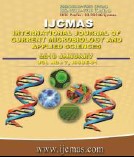


 National Academy of Agricultural Sciences (NAAS)
National Academy of Agricultural Sciences (NAAS)

|
PRINT ISSN : 2319-7692
Online ISSN : 2319-7706 Issues : 12 per year Publisher : Excellent Publishers Email : editorijcmas@gmail.com / submit@ijcmas.com Editor-in-chief: Dr.M.Prakash Index Copernicus ICV 2018: 95.39 NAAS RATING 2020: 5.38 |
The chemical, biochemical and biological parameters of organic extracts differ from substrates being used for preparation and this work aimed at selecting a suitable substrate for active decomposition of organic wastes with Eisenea sp. and for extraction of vermiwash that could sustain the soil capacities both chemically and biologically. Different substrates namely Prosopis, Albizia, Azadirachta, Azolla, Leucaena, Eichornia and Banana pseudostem were used for preparation of vermicompost along with cowdung (10:1w/w basis). From the active compost, vermiwash was collected @ 40 litres of vermiwash from one complete cycle and different parameters were assessed. Among the different substrates tested, neem leaf vermiwash proved to be a better source of nitrogen fixing, phosphate solubilising, cellulolytic and starch degrading microorganisms. Nitrogen fixing Azospirillum sp. registered 200x104 CFU ml-1 followed by Azotobacter sp. 61x104CFU ml-1. Phosphorus solubilizing bacteria numbered to 4x102 CFU ml-1 and that of fluorescent Pseudomonads was 37x104 CFU ml-1. The cellulose and starch degraders outnumbered the other microbes each with a count of 325 x104 CFU ml-1. The nutrient composition of the neem leaf vermiwash was 53.30 ppm of nitrogen, 12ppm of phosphorus and 223 ppm of potassium. The micronutrients zinc, iron, copper and manganese were present at 0.06, 1.08, 0.04 and 0.01 ppm levels. The presence of the plant hormones viz., Indole Acetic Acid (1.25ppm) and Gibberellic acid (1.65 ppm) added value to the vermiwash. With these diversified biochemical and microbial components, it is concluded that neem leaf vermiwash could be able to sustain the production capacities of soil and that could be developed as an organic supplement for plant growth promotion.
 |
 |
 |
 |
 |